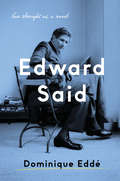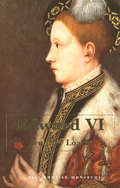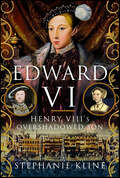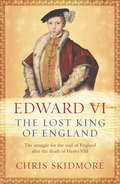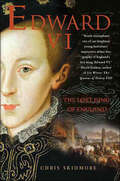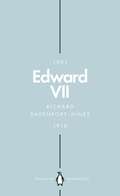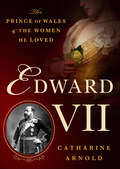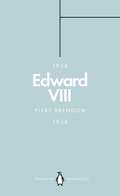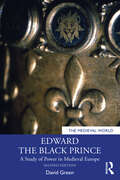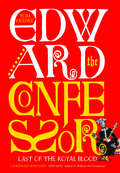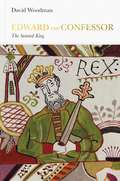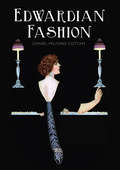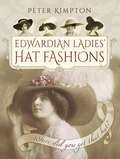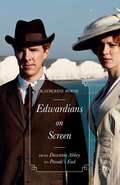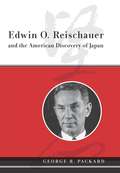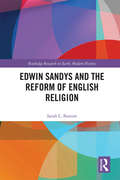- Table View
- List View
Edward Said: His Thought as a Novel
by Dominique EddeAn intimate account of Edward Saïd's life and thoughtEdward Said is a personal, literary portrait of one of the twentieth century’s most influential scholars, written by his close friend and confidante. Here, Lebanese novelist and essayist Dominique Eddé offers a fascinating and fresh presentation of his oeuvre from his earliest writings on Joseph Conrad to his most famous texts, Orientalism and Culture and Imperialism. Eddé weaves together accounts of the genesis and content of Said’s work, his intellectual development, and her own reflections and personal recollections of their friendship, which began in 1979 and lasted until Said’s death in 2003. In this intimate and searching portrait of Said’s thought, Eddé continues to maintain their dialogue despite his death, trying to make peace with the loss of a collaborator with whom she still wants to talk and disagree.Bringing together personal reflection and theoretical innovation, reflective mourning and immediate argument, Eddé has written a testament to a great intellectual passion.Both specialists of Said’s work and newcomers will find much to learn in this rich portrait of one of the twentieth century’s most important intellectuals.
Edward VI
by Jennifer LoachEdward VI was the son of Henry VIII and his second wife, Jane Seymour. He ruled for only six years (1547-1553) and died at the age of sixteen. But these were years of fundamental importance in the history of the English state, and in particular of the English church. This new biography reveals for the first time that, despite his youth, Edward had a significant personal impact. Jennifer Loach draws a fresh portrait of the boy king as a highly precocious, well educated, intellectually confident, and remarkably decisive youth, with clear views on the future of the English church. Loach also offers a new understanding of Edward's health, arguing that the cause of his death was a severe infection of the lungs rather than tuberculosis, the commonly accepted diagnosis. The author views Edward not as a sickly child but as a healthy and vigorous boy, devoted to hunting and tournaments like any young aristocrat of the day.This book tells the story of the monarch and of his time. It supplies the dramatic context in which the short reign of Edward VI was played out--the momentous religious changes, factional fights, and popular risings. And it offers vivid details on Edward's increasing absorption in politics, his consciousness of his role as supreme head of the English church, his determination to lay the foundation for a Protestant regime, and how his failure in this ambition brought England to the brink of civil war.
Edward VI: Henry VIII's Overshadowed Son
by Stephanie KlineFor too long, King Edward VI has been pushed to the very edges of Tudor history - overlooked in favor of some of the more vibrant personalities of his family members, such as Henry VIII and Elizabeth I. Known as the 'boy king' of the Tudor dynasty, he is often remembered for little more than the ambitious councillors who governed England during his minority. His reign, however, and the significant religious changes that took place as he furthered the Protestant Reformation in England, had great influence over the remaining decades of the Tudor period and even modern Britain as we know it today. ‘Boy king’ though he may have been, Edward VI and his government were more significant to the history of England than he is often given credit for, and it is long past time for careful and thoughtful study of his life and reign. Edward VI: Henry VIII’s Overshadowed Son aims to reopen the pages of his story, arguing that however brief it may have been, Edward VI’s reign had lasting impacts on the religious landscape in England, and is certainly a Tudor reign worth remembering.
Edward VI: The Last Boy King (Penguin Monarchs)
by Stephen AlfordEdward VI, the only son of Henry VIII, became king at the age of nine and died wholly unexpectedly at the age of fifteen. All around him loomed powerful men who hoped to use the child to further their own ends, but who were also playing a long game - assuming that Edward would long outlive them and become as commanding a figure as his father had been. Stephen Alford's wonderful book gives full play to the murky, sinister nature of Edward's reign, but is also a poignant account of a boy learning to rule, learning to enjoy his growing power and to come out of the shadows of the great aristocrats around him. England's last child monarch, Edward would have led his country in a quite different direction to the catastrophic one caused by his death.
Edward VI: The Lost King of England
by Chris SkidmoreThe struggle for the soul of England after the death of Henry VIIIIn the death of Henry VIII, the crown passed to his nine-year-old son, Edward. However, real power went to the Protector, Edward's uncle, the Duke of Somerset. The court had been a hotbed of intrigue since the last days of Henry VIII. Without an adult monarch, the stakes were even higher. The first challenger was the duke's own brother: he seduced Henry VIII's former queen, Katherine Parr; having married her, he pursued Princess Elizabeth and later was accused of trying to kidnap the boy king at gunpoint. He was beheaded. Somerset ultimately met the same fate, after a coup d'etat organized by the Duke of Warwick. Chris Skidmore reveals how the countrywide rebellions of 1549 were orchestrated by the plotters at court and were all connected to the (literally) burning issue of religion: Henry VIII had left England in religious limbo. Court intrigue, deceit and treason very nearly plunged the country into civil war. Edward was a precocious child, as his letters in French and Latin demonstrate. He kept a secret diary, written partly in Greek, which few of his courtiers could read. In 1551, at the age of 14, he took part in his first jousting tournament, an essential demonstration of physical prowess in a very physical age. Within a year it is his signature we find at the bottom of the Council minutes, yet in early 1553 he contracted a chest infection and later died, rumours circulating that he might have been poisoned. Mary, Edward's eldest sister, and devoted Catholic, was proclaimed Queen. This is more than just a story of bloodthirsty power struggles, but how the Church moved so far along Protestant lines that Mary would be unable to turn the clock back. It is also the story of a boy born to absolute power, whose own writings and letters offer a compelling picture of a life full of promise, but tragically cut short.
Edward VI: The Lost King of England
by Chris SkidmoreThe birth of Edward on October 12, 1537, ended his father's twenty-seven-year wait for an heir. Nine years later, Edward was on the throne, a boy-king in a court where manipulation, treachery, and plotting were rife.Henry VIII's death in January 1547 marked the end of a political giant whose reign had dominated his kingdom with an iron grip for thirty-eight years. Few could remember an England without him---certainly little had remained untouched: the monasteries and friaries had been ripped down, the Pope's authority discarded, and new authoritarian laws had been introduced that placed his subjects under constant fear of death.Edward came to the throne promising a new start; the harsh legislation of his father's was repealed and the country's social and economic problems approached with greater sensitivity. Yet the early hope and promise he offered soon turned sour. Despite the terms of Henry's will, real power had gone to just one man---the Protector, Edward's uncle, the Duke of Somerset, and there were violent struggles for power, headed by the duke's own brother, Thomas Seymour.Chris Skidmore reveals how the countrywide rebellions of 1549 were orchestrated by the plotters at court and were all connected to the burning issue of religion: Henry VIII had left England in a religious limbo. Court intrigue, deceit, and treason very nearly plunged the country into civil war. The stability that the Tudors had sought to achieve came close to being torn apart in the six years of Edward's reign.Even today, the two dominant figures of the Tudor period are held to be Henry VIII and Elizabeth I. Yet Edward's reign is equally important. His reign was one of dramatic change and tumult, yet many of the changes that were instigated during this period---certainly in terms of religious reformation---not only exceeded Henry's ambitions but have endured for over four centuries since Edward's death in 1553.
Edward VII: The Cosmopolitan King (Penguin Monarchs)
by Richard Davenport-HinesLike his mother Queen Victoria, Edward VII defined an era. Both reflected the personalties of their central figures: hers grand, imperial and pretty stiff; his no less grand, but much more relaxed and enjoyable. This book conveys Edward's distinct personality and significant influences. To the despair of his parents, he rebelled as a young man, conducting many affairs and living a life of pleasure. But as king he made a distinct contribution to European diplomacy and - which is little known - to London, laying out the Mall and Admiralty Arch. Richard Davenport-Hines's book is as enjoyable as its subject and the age he made.
Edward VII: The Last Victorian King
by Christopher HibbertA riveting biography that vividly captures the life and times of the last Victorian king.To his mother, Queen Victoria, he was "poor Bertie," to his wife he was "my dear little man," while the President of France called him "a great English king," and the German Kaiser condemned him as "an old peacock." King Edward VII was all these things and more, as Hibbert reveals in this captivating biography. Shedding new light on the scandals that peppered his life, Hibbert reveals Edward's dismal early years under Victoria's iron rule, his terror of boredom that led to a lively social life at home and abroad, and his eventual ascent to the throne at age 59. Edward is best remembered as the last Victorian king, the monarch who installed the office of Prime Minister.
Edward VII: The Prince of Wales and the Women He Loved
by Catharine Arnold“Victorian England: We know what that was supposed to mean — all priggish prudery and "we-are-not-amused" harrumphing. Except now we know it wasn't all that . . . [Catharine Arnold’s] new biography focuses — deliciously — on the women who shared the scandalously plentiful sex life of Queen Victoria's eldest son, the Prince of Wales, later Edward VII.” —USA TodayEdward Prince of Wales, better known as “Bertie,” was the eldest son of Queen Victoria. Charming and dissolute, he was a larger-than-life personality with king-size appetites. A lifelong womanizer, Bertie conducted his countless liaisons against the glittering backdrop of London society, Europe, and the stately homes of England in the second half of the 19th century. Bertie’s lovers were beautiful, spirited, society women who embraced a wide field of occupations. There was Lillie Langtry, the simple Jersey girl who would become an actress and producer; “Daisy” Brooke, Countess of Warwick, the extravagant socialite who embraced socialism and stood for Parliament as a Labour party candidate; bisexual French actress Sarah Bernhardt, celebrated for her decadent appeal and opium habit; and by total contrast the starchy Agnes Keyser, who founded a hospital for army officers. One of Bertie’s most intriguing liaisons was with American heiress Jennie Churchill, unhappy wife of Sir Randolph Churchill and mother of Sir Winston. While the scandals resulting from his affairs—from suicides to divorces—were a blight on the royal family, Bertie would become a surprisingly modern monarch. His major accomplishment was transforming the British monarchy into the modern institution that we know today and ensuring its survival in a period when every other European dynasty collapsed in the wake of WWI.
Edward VIII: The Road to Abdication
by Frances DonaldsonTraces the events which lead to Edward's Abdication.
Edward VIII: The Uncrowned King (Penguin Monarchs)
by Piers Brendon'After my death,' George V said of his eldest son and heir, 'the boy will ruin himself within twelve months.'The forecast proved uncannily accurate. Edward VIII came to the throne in January 1936, provoked a constitutional crisis by his determination to marry the American divorcée Wallis Simpson, and abdicated in December. He was never crowned king.In choosing the woman he loved over his royal birthright, Edward shook the monarchy to its foundations. Given the new title 'Duke of Windsor' and essentially sent into exile, he remained a visible skeleton in the royal cupboard until his death in 1972 and he haunts the house of Windsor to this day.Drawing on unpublished material, notably correspondence with his most loyal (though much tried) supporter Winston Churchill, Piers Brendon's superb biography traces Edward's tumultuous public and private life from bright young prince to troubled sovereign, from wartime colonial governor to sad but glittering expatriate. With pace and panache, it cuts through the myths that still surround this most controversial of modern British monarchs.
Edward the Black Prince: A Study of Power in Medieval Europe (The Medieval World)
by David GreenThis fully updated second edition uses the career of Edward the Black Prince to explore key developments in the history of late medieval Europe. The eruption of the Hundred Years War, the arrival of the Black Death, England’s first religious heresy, and major innovations in the role of parliament all took place during Edward’s lifetime. As king-in-waiting and one of the most significant noblemen in the realm, the prince was a major influence over local and international politics, and his example helped reshape concepts of lordship throughout the Plantagenet estates. This thoroughly revised edition includes new sources and builds on the wealth of scholarship which has been published in recent years about the fourteenth century. It includes considerations of the prince’s military career in France and Iberia, his household and the ‘colonial’ characteristics of his administrations in Wales and Aquitaine. The prince’s career also reveals the influence of the chivalric ethic and the importance of Gascony to the English crown, while his relationship with Joan, ‘the Fair Maid’ of Kent is suggestive of the changing character of female agency in the later middle ages. Drawing on central themes such as plague, chivalry, lordship, parliament, gender, and religion, Edward the Black Prince is essential reading for all students and scholars concerned with society, culture, and power in medieval Europe.
Edward the Caresser: The Playboy Prince Who Became Edward VII
by Stanley WeintraubA weak English King at a critical time.
Edward the Confessor: Last of the Royal Blood (The English Monarchs Series)
by Tom LicenceAn authoritative life of Edward the Confessor, the monarch whose death sparked the invasion of 1066 One of the last kings of Anglo-Saxon England, Edward the Confessor regained the throne for the House of Wessex and is the only English monarch to have been canonized. Often cast as a reluctant ruler, easily manipulated by his in-laws, he has been blamed for causing the invasion of 1066—the last successful conquest of England by a foreign power. Tom Licence navigates the contemporary webs of political deceit to present a strikingly different Edward. He was a compassionate man and conscientious ruler, whose reign marked an interval of peace and prosperity between periods of strife. More than any monarch before, he exploited the mystique of royalty to capture the hearts of his subjects. This compelling biography provides a much-needed reassessment of Edward&’s reign—calling into doubt the legitimacy of his successors and rewriting the ending of Anglo-Saxon England.
Edward the Confessor: The Sainted King (Penguin Monarchs)
by David WoodmanEdward the Confessor, the last great king of Anglo-Saxon England, canonized nearly 100 years after his death, is in part a figure of myths created in the late middle ages.In this revealing portrait of England's royal saint, David Woodman traces the course of Edward's twenty-four-year-long reign through the lens of contemporary sources, from the Anglo-Saxon Chronicle and the Vita Ædwardi Regis to the Bayeux Tapestry, to separate myth from history and uncover the complex politics of his life. He shows Edward to be a shrewd politician who, having endured a long period of exile from England in his youth, ascended the throne in 1042 and came to control a highly sophisticated and powerful administration.The twists and turns of Edward's reign are generally seen as a prelude to the Norman Conquest in 1066. Woodman explains clearly how events unfolded and personalities interacted but, unlike many, he shows a capable and impressive king at the centre of them.
Edward the Elder: 899-924
by N. J. Higham D. H. HillEdward the Elder, son and successor of King Alfred, was one of the greatest architects of the English state and yet is one of the most neglected kings of English history. During his 24-year reign, Edward led a series of successful campaigns against the Vikings and by the time of his death controlled most of southern and midland England, with his influence also felt in Wales and the north. Edward the Elder is a timely reassessment of his reign and helps to restore this ruler to his rightful place in English history.The period of Edward's reign is notably lacking in primary materials for historians. But by drawing upon sources as diverse as literature, archaeology, coins and textiles, this book brings together a rich variety of scholarship to offer new insight into the world of Edward the Elder. With this wealth of perspectives, Edward the Elder offers a broad picture of Edward's reign and his relation to the politics and culture of the Anglo-Saxon period.
Edwardian Cooking: The Unofficial Downton Abbey Cookbook
by Larry EdwardsThe PBS Masterpiece series Downton Abbey has taken the world by storm. With 80 delicious recipes, this cookbook celebrates the phenomenal success of the series and the culinary wonders enjoyed by the aristocracy in Edwardian England. Starting with an elegant array of savory tea sandwiches and sweets from traditional high tea, this book guides you through dinner at the Edwardian table with its: Infinite variety of breads-Dinner Biscuits, Estate Oat Bread, Downton Dinner Rolls, and many more Soups-Majestic Potato Soup, Royal Cheddar Cheese Soup, Stilton Chowder Side Dishes-Asparagus in Cider Sauce, Baked Creamed Turnips, Shredded Spiced Brussels Sprouts, Savory Caraway Cabbage Entrées-Edwardian Leg of Lamb, Lobster Pudding, Oyster Roll, Leek Pie, Downton Pheasant Casserole, Pork Loaf with Apples Dessert at the Abbey-Lemon Creme Soufflé, Raspberries in Sherry Sabayon Sauce, Queen Victoria Rice Pudding, Downton Abbey Honey CakeWith recipes adapted for the modern cook by Chef Larry Edwards, these dishes are as inspiring as they are easy to make.
Edwardian Devon 1900-1914: Before the Lights Went Out
by David ParkerA century ago, Britain was locked in a devastating worldwide conflict that would change every aspect of society. This book explores life in Devon between 1900 and 1914, offering a revealing glimpse of a world now long-vanished before war broke out. Devon was no backwater; its railways and shipping were busy bringing tourists in and sending vast quantities of produce out. It was, though, a county of contrasts and change. Farming had reinvented itself after the late Victorian depression, but villages were in decline; churches and chapels were full but religion bitterly divided communities; the wealthy enjoyed extravagant lifestyles on great estates but their authority was under attack. Devon’s upper-, middle- and lower-class schools perfectly reflected the Edwardian social hierarchy, but as the county’s elections revealed, society was being torn asunder by bitter controversies over exactly who should have the vote, rule the country, and control the Empire. It was a worrying time overseas too: Great Britain’s supremacy was increasingly challenged, and the warships in Devon’s harbours and army manoeuvres on the moors drew many comments as the storm clouds began to gather over Europe. Using mainly contemporary sources, this engaging book examines the attitudes and experiences of people across all social classes in this tumultuous era.
Edwardian Fashion
by Daniel CottamFashion in the Edwardian period underwent some quite revolutionary changes. The delicately coloured, flower-and-lace-trimmed trailing gowns and elaborate hairstyles worn by tightly corseted fashionable ladies in the early years of Edward VII's reign would transform into the boldly coloured, dramatically stylized Eastern-inspired kimono wraps, slender hobble skirts, ankle-skimming tunic dresses and turbans of 1914 on the eve of the First World War. This book presents the story of women's and men's dress through this exciting period, and is a fascinating addition to the bestselling Shire fashion list that already includes Fashion in the Time of Jane Austen and Fashion in the Time of the Great Gatsby.
Edwardian Ladies' Hat Fashions: Where Did You Get That Hat? (Images Of The Past Ser.)
by Peter KimptonBased upon the authors large personal collection of beautiful fashion postcards from Edwardian times, this book takes the reader on a journey through that era covering the hat fashions and social changes of the day. Delve further into the carnage that took place around the world, in which unscrupulous and money grabbing individuals from the Northumbrian coast in England to the Everglades in America, would callously slaughter whole colonies of birds (leaving their young to die) purely to provide the millinery trade with ornate feathers to decorate fashionable hats during that era.The book also takes the reader into the world of millinery sweatshops of poverty stricken New York and describes the conditions and deprivations under which the poorly paid workers, many of them immigrants, worked. You can even learn about the background, history and amazing life of one of the worlds greatest fashion designers, Coco Chanel, as she set out on her lifetime of fashion in Edwardian Paris.With superb fashion colour plates of the day, together with images of amazingly creative and colourful hat pins from both the UK and America, the author shares the fruits of his 40 years of postcard collecting and the highs and lows of his search for the 'Hats' postcards, as worn by his Edwardian 'girlfriends' from over 100 year ago.
Edwardian Turn Of Mind
by Samuel HynesThe Edwardian Turn of Mind brilliantly evokes the cultural temper of an age. The years between the death of Queen Victoria and the outbreak of the First World War witnessed a turbulent and dramatic struggle between the old and the new. Samuel Hynes considers the principal areas of conflict - politics, science, the arts and the relations between men and women - and fills them with a wide-ranging cast of characters: Tories, Liberals and Socialists, artists and reformers, psychoanalysts and psychic researchers, sexologists, suffragettes and censors. His book is a portrait of a tumultuous time - out of which contemporary England was made.
Edwardians on Screen: From Downton Abbey to Parade’s End
by Katherine ByrneThis book explores television's current fascination with the Edwardian era. By exploring popular period dramas such as Downton Abbey , it examines how the early twentieth century is represented on our screens, and what these shows tell us about class, gender and politics, both past and present.
Edwin O. Reischauer and the American Discovery of Japan
by George PackardIn 1961, President Kennedy named Edwin O. Reischauer the U.S. Ambassador to Japan. Already deeply intimate with the country, Reischauer hoped to establish a more equal partnership with Japan, which had long been maligned in the American imagination. Reischauer pushed his fellow citizens to abandon caricature and stereotype and recognize Japan as a peace-loving democracy. Though his efforts were often condemned for being "too soft," the immensity of his influence (and the truth of his arguments) can be felt today. Having worked as Reischauer's special assistant in Tokyo, George R. Packard writes the definitive-and first-biography of this rare, charismatic talent. Reischauer reset the balance between two powerful nations. During World War II, he analyzed intelligence and trained American codebreakers in Japanese. He helped steer Japan toward democracy and then wrote its definitive English-language history. Reischauer's scholarship supplied the foundations for future East Asian disciplines, and his prescient research foretold America's missteps with China and involvement in Vietnam. At the time of his death in 1990, Reischauer warned the U.S. against adopting an attitude toward Asia that was too narrow and self-centered. India, Pakistan, and North Korea are now nuclear powers, and Reischauer's political brilliance has become more necessary and trenchant than ever.
Edwin O. Reischauer and the American Discovery of Japan
by George R. PackardIn 1961, President Kennedy named Edwin O. Reischauer the U.S. Ambassador to Japan. Already deeply intimate with the country, Reischauer hoped to establish a more equal partnership with Japan, which had long been maligned in the American imagination. Reischauer pushed his fellow citizens to abandon caricature and stereotype and recognize Japan as a peace-loving democracy. Though his efforts were often condemned for being "too soft," the immensity of his influence (and the truth of his arguments) can be felt today. Having worked as Reischauer's special assistant in Tokyo, George R. Packard writes the definitive - and first - biography of this rare, charismatic talent. Reischauer reset the balance between two powerful nations. During World War II, he analyzed intelligence and trained American codebreakers in Japanese. He helped steer Japan toward democracy and then wrote its definitive English-language history. Reischauer's scholarship supplied the foundations for future East Asian disciplines, and his prescient research foretold America's missteps with China and involvement in Vietnam. At the time of his death in 1990, Reischauer warned the U.S. against adopting an attitude toward Asia that was too narrow and self-centered. India, Pakistan, and North Korea are now nuclear powers, and Reischauer's political brilliance has become more necessary and trenchant than ever.
Edwin Sandys and the Reform of English Religion
by Sarah L. BastowThis book examines the complexities of reformed religion in early-modern England, through an examination of the experiences of Edwin Sandys, a prominent member of the Elizabethan Church hierarchy. Sandys was an ardent evangelical in the Edwardian era forced into exile under Mary I, but on his return to England he became a leader of the Elizabethan Church. He was Bishop of Worcester and London and finally Archbishop of York. His transformation from Edwardian radical to a defender of the Elizabethan status quo illustrated the changing role of the Protestant hierarchy. His fight against Catholicism dominated much of his actions, but his irascible personality also saw him embroiled in numerous conflicts and left him needing to defend his own status.
